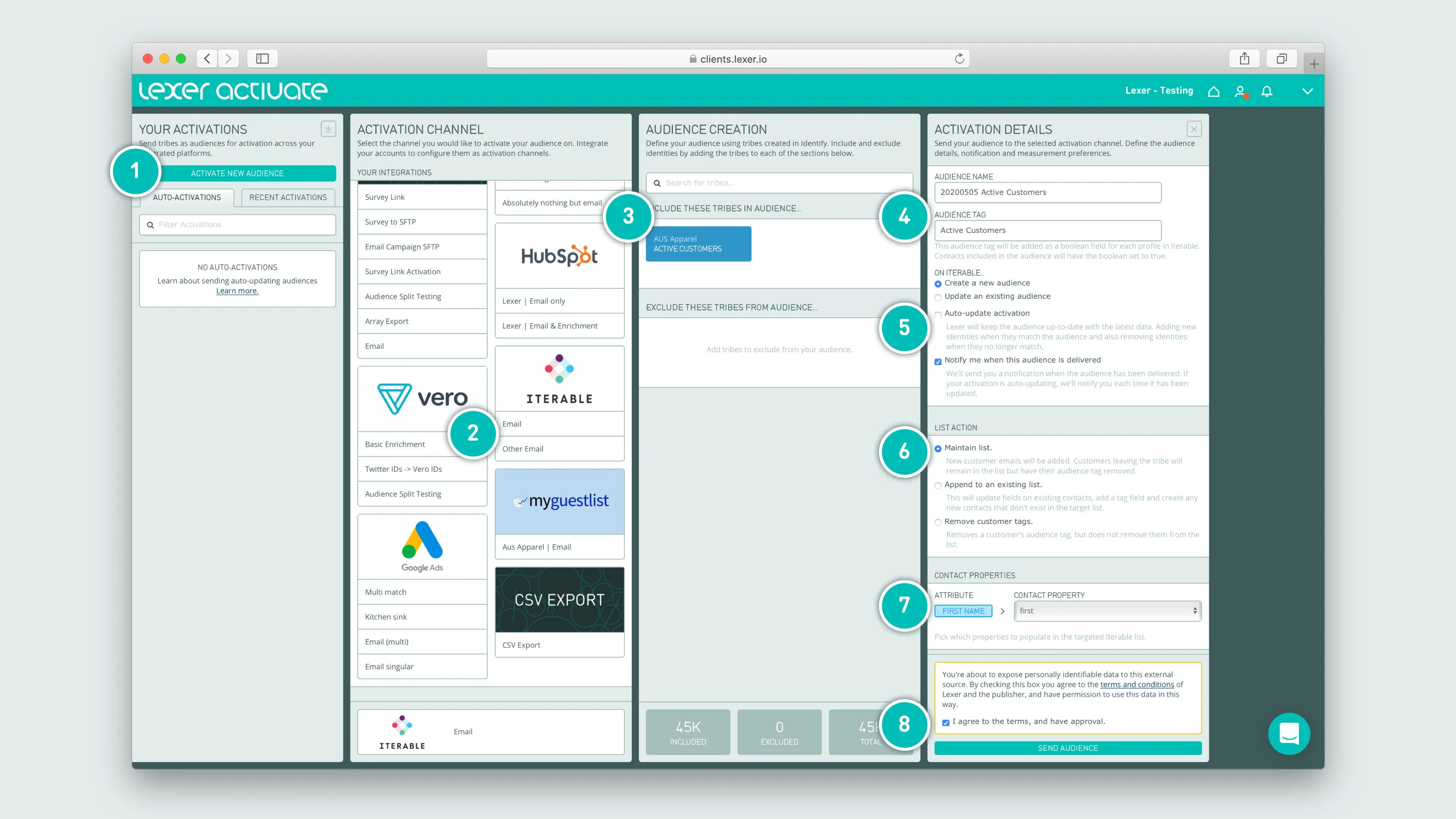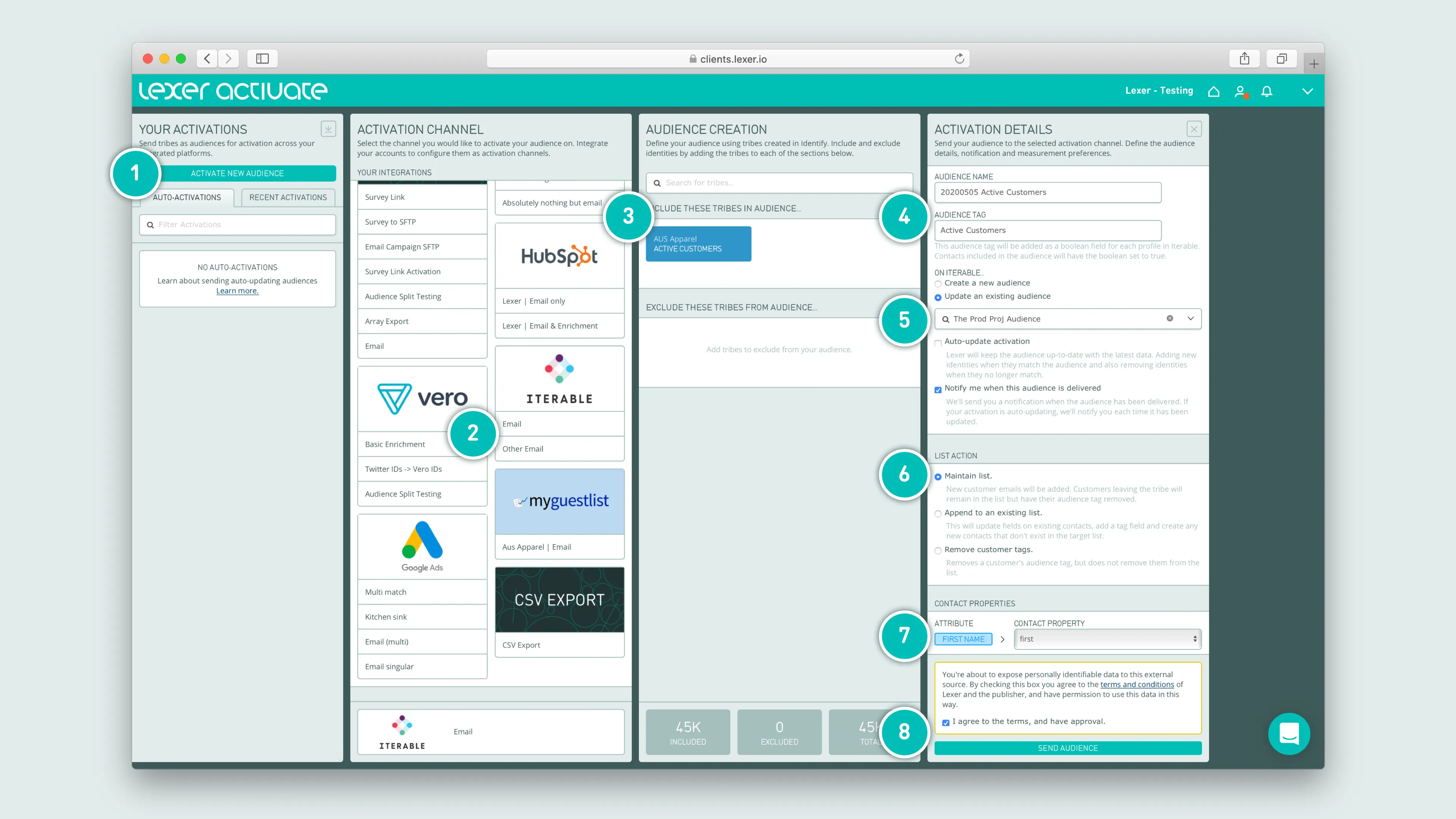Iterable
This integration is in beta
As with all beta tests, not everything will be perfect. If you run into any issues, please submit a support ticket.
Connect your Iterable account with Lexer
Connecting your Lexer and Iterable account will allow Lexer to start capturing customer engagement data like email opens, clicks, and subscriber statuses. To connect your Iterable account with Lexer you must first create a Webhook within Iterable. Once your webhook is created, you will generate an API key within Iterable, and save that back into Lexer completing the connection.
Benefits of an Iterable integration
Integrating your Iterable account with Lexer provides a number of benefits, such as:
- Import your contacts as enriched Profiles
- Capture engagement metrics and statuses
- Create dynamic customer Segments in Iterable for marketing activation
Integration in a nutshell
Here's a summary of how Iterable integrates with Lexer:
Direction
What direction does the data flow?
✅ Data in: import your contacts as enriched profiles.
✅ Data out: customer email and SMS lists for marketing campaigns.
Type
Lexer loads these types of data
✅ Email (ESP)
Source method
How Lexer loads data from this source.
✅ Webhooks
Destination method
How Lexer sends data to this source.
✅ API
Status
What is the status of the integration?
Full Release
Lexer product compatibility
What Lexer products is the integration compatible with?
✅ Activate
✅ Compare
✅ Segment
✅ Track
⬜️ Listen
⬜️ Respond
⬜️ Serve
Attributes
No attributes will be created as part of this integration.
Attributes
This integration allows for some flexibility, the output of the integration depends on your available data and what you send through to Lexer. In addition, your attributes could be named in a different way to other clients. If you would like a list of attributes related to this integration, please email your Success Manager.
Attributes
What attributes are created when integrated with Lexer?
N/A
Attributes
These are the standard attributes that Lexer can create from the data received via this integration. The exact attributes will depend on what data is made available and sent into Lexer. Keep in mind, your attribute names may vary slightly. If you have any questions or would like to explore custom options, please contact your Success Manager.
Customer attributes
Email engagement attributes
SMS event attributes
Transactional attributes
Product attributes
Setting up your Iterable Webhook
This will involve making a new "systems webhook", which are located under the Integrations menu header in Iterable. Clicking this link should take you there also.

- Click + CREATE WEBHOOK
- Paste in this endpoint URL https://webhooks.lexer.io/iterable and leave Auth Type set to NoAuth
- Click CREATE WEBHOOK
- Set your webhook to ENABLED
- Check the options listed below under Webhook Permissions
- Click Save
Webhook Permissions
- Email: Blast Send, Triggered Send, Click, Open, Subscribe, Unsubscribe
- SMS: Send
- Push: Send, Open
- In-app: Click, Open
Integrating Iterable and Lexer
You’ve now created your webhook. To finish this setup you will need to generate an API key for your Iterable account, and save that in Lexer Integrate. Follow the steps below;

- Under the Integrations menu, click API KEYS
- Click + CREATE NEW API KEY…
- Select STANDARD from the drop-down menu and click CREATE
- Copy the newly generated key

- Navigate to Lexer Integrate
- Click the Iterable Tile and then click INTEGRATE ITERABLE
- Give your integration a name
- Paste in your API key
- Click SAVE INTEGRATION
What is the Iterable activation?
Iterable is a growth marketing platform, with a focus on email, SMS, in-app and web push marketing communications.
Connecting your Iterable account with Lexer allows you to create new lists, and update existing ones for marketing purposes. When you make a new list or update an existing one, the Lexer activation will append a boolean field to each Profile within that list, marking them as either in (TRUE) or out (FALSE) of the Segment.
Send a Segment to Iterable
Before you get started, make sure you’ve done the following:
- Integrated your Iterable account with Lexer.
- Created an activation to Iterable (reach out to Lexer Support (support@lexer.io) if not)
- Built your Segment/s in Lexer Segment.
Activate and make a new list in Iterable

- Click ACTIVATE NEW AUDIENCE
- Select the appropriate Iterable account for this Activation
- Add your Segment(s)
- Update the audience name and tag as required (the audience tag will become your new list’s name)
- Set the list to auto-update if needed
- Set the appropriate list action. In most cases, leave it on Maintain list
- Use the drop-downs to map the Attributes you’d like to enrich in Iterable
- Agree to terms, and click Send Audience
Activate and update a list in Iterable

- Click ACTIVATE NEW AUDIENCE
- Select the appropriate Iterable account for this Activation
- Add your Segment(s)
- Update the audience name and tag fields as required, the tag field will become the name of the new boolean field in Iterable
- Using the drop-down select the list you would like to update
- Set the appropriate list action. In most cases, leave it on Maintain list
- Use the drop downs to map Attributes you’d like to enrich in Iterable
- Agree to terms, and click Send Audience
Set and forget — auto-updating audiences
Lexer Activate permits you to automatically update your audiences within Iterable. With this selected, Lexer will add or remove customers from your audience as they enter and leave your Segment.
Okay I’ve sent my audience, what next?
The moment your activation has been confirmed as sent in Activate, you’ll see records begin to update in Iterable. We’ll send you an email to let you know once an audience has been sent - the time this takes will vary, depending on the size of the audience.
To learn more about sending email and SMS campaigns in Iterable, see their help documents here.
